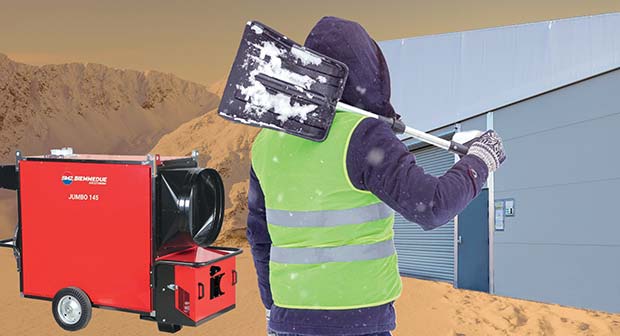Autumn is a good time to ensure your temporary building will be adequately lit, heated and insulated for the winter months. An insulated or part-insulated building will reduce the effects of condensation and maintain an ambient temperature for stored goods, as well as providing a comfortable working environment.
 While there’s no law for minimum or maximum working temperatures, the Approved Code of Practice suggests the minimum temperature in a workplace should normally be at least 16 degrees Celsius. If the work involves rigorous physical effort, this reduces to 13 degrees Celsius. With UK temperatures averaging between 2-7?C in Winter, investment in an insulated building with heating will aid workforce productivity and help to keep equipment and stock moisture-free.
While there’s no law for minimum or maximum working temperatures, the Approved Code of Practice suggests the minimum temperature in a workplace should normally be at least 16 degrees Celsius. If the work involves rigorous physical effort, this reduces to 13 degrees Celsius. With UK temperatures averaging between 2-7?C in Winter, investment in an insulated building with heating will aid workforce productivity and help to keep equipment and stock moisture-free.
Lighting
It may seem obvious, but good lighting at work is an essential part of health and safety in the workplace, from avoiding hazards to reducing eyestrain and headaches. The types of hazard present at work therefore determine the lighting requirements for safe operation. Poor lighting at work can have significant cost implications for a business caused by absenteeism and reduced productivity. Apart from health and safety, there are also environmental and energy efficiencies to consider.
For most temporary buildings, a product such as the LED High/Low Bay 151W Light is suitable. It provides high luminous efficiency and up to 60% energy savings. This is achieved with the added feature of microwave or daylight sensors that operate the luminaire when motion or a lack of daylight is detected. The light bulbs in this type of light can be easily changed to create a softer light effect for a different type of application, such as a retail or sports facility.
Roofing
The Aganto ‘Protect Range’ buildings use single skin roofing. This is an economical solution that provides adequate cover when temperature control is not required. The Insulate Range provides effective temperature and sound insulation, while reducing condensation and mould. This roofing type has a double skin PVC polyester membrane envelope, which is inflated to create a layer of air.
After the twin layer sheets are pulled in the Keder-grooves of the structure, they are inflated with a special designed air pressure unit; a process which requires minimum energy. The air supply system (flexible pipes) supplies the air to the individual roof sheets. The air pressure unit maintains a constant level of air pressure.
In addition to protecting against microbial and fungal spores, the acrylic-coated fabric is designed to allow natural light through without UV-damage, keeping the need for artificial lighting to a minimum. It is a comparatively lightweight yet strong material, which is easy to clean, flame retardant, and available in various colours and finishes; it can even be branded with company logos and graphics.
Cladding
There are ranges of cladding types and colours to choose from. For more sensitive storage applications insulated steel sandwich walling is an effective solution to reduce the cost of heating/cooling and structural noise throughout the year. Buildings can be fully insulated, or part insulated to suit, and the modular design makes it possible to switch panels over quickly and easily if needed.
Heating options
Jumbo oil-fired heaters are ideal for most temporary building applications, and smaller EC models, usually used for marquees, are also available. To select the correct heater for your needs, consider what temperature range you would like to achieve. The BTU – or British Thermal Unit – requirement can then be calculated according to the cubic capacity of your building (with allowances for open doors, refrigerated areas, etc). The heaters are available for annual hire, which includes a 12-month service to keep the machine in top condition.




Comments are closed.